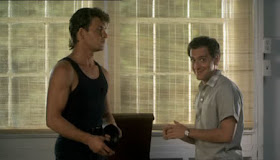 |
| Johnny Castle and Neil Kellerman discuss the feature dance for the final show |
NeilThe conversation between Johnny and Neil is important, because Baby subsequently advises Johnny to continue to assert his own opinion. Baby's advice eventually will cause Johnny to appreciate her wisdom and courage, which he praises publicly in the final scene.
My grandfather put me in charge of the final show. I want to talk to you about the last dance. I'd like to shake things up a bit. You know, move with the times.
Johnny
I've got a lot of ideas. I've been working with the staff kids on a cross between a Cuban rhythm and soul dancing.
Neil
Whoa, boy. Way over your head here. You always do the mambo. Why not dance this year's final dance to the pachanga?
Johnny
[Sarcastically:] Right.
Neil
Well, you're free to do the same, tired number as last year if you want, but next year we'll find another dance person who'll only be too happy ...
Johnny
Sure, Neil. No problem. We'll end the season with the pachanga. Great idea.
Neil
[Addressing Baby:] Sometimes he [Johnny] is hard to talk to, but the ladies seem to like him. See that he gives you the full half-hour [lesson] you're paying him for, kid. [Neil exits.]
Johnny
That little wimp. He wouldn't know a new idea if it hit him in the pachanga. I could have told him some new ideas.
Baby--------
Why did you let him talk to you that way?
Johnny
What, fight the boss man?
Baby
You tell him your ideas. He's a person like everyone else.
Johnny
Look, I know these people. They are rich and they're mean. They won't listen to me.
Baby
Why not fight harder? Make them listen.
The Wikipedia article on Pachanga reports that this genre of music and dance emerged in the USA at the end of the 1950s.
Pachanga is a genre of music which is described as a mixture of son montuno and merengue. This type of music has a festive, lively style and is marked by jocular, mischievous lyrics.Since the Dirty Dancing story takes place in 1963, pachanga music and dancing was only about four years old (from 1959) in the USA. Neil was suggesting something that indeed was quite new.
In Cuba in 1955, the band Los Papines fused the violin-based music of charanga with trumpet-based music. The name [Pachanga] came about to describe the genre in Cuba in 1959. Pachanga is ... a style of music in Cuba played with violin, flute and drums as danzón, danzonetes and cha cha chá.
... After Fidel Castro seized power in Cuba in 1959, the epicenter of Cuban music moved to other islands and USA. José Fajardo brought the song "La Pachanga" to New York.
As a dance, pachanga has been described as "a happy-go-lucky dance" of Cuban origin with a Charleston flavor due to the double bending and straightening of the knees. It is danced to the downbeat of four-four time to the usual mambo offbeat music characterized by the charanga instrumentation of flutes, violins, and drums.
Here is a recording of Fajardo's band performing the song "La Pachanga".
Eddie Torres demonstrates pachanga dance moves.
Torres dances the pachanga with Grisel Ponce.
However, Johnny wanted to create something new -- a cross between a Cuban rhythm and soul dancing.
What might Johnny have created? I went to YouTube and used the search expression a cross between a Cuban rhythm and soul dancing, and I found ...
... the Latin Soul Dancers ....
... and Dancers of Habana Compas ...
... and Carmen la Cubana ...
No comments:
Post a Comment